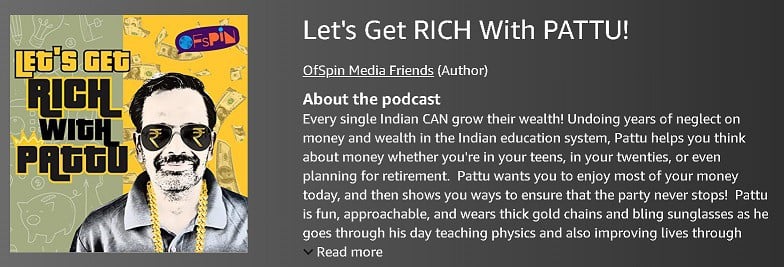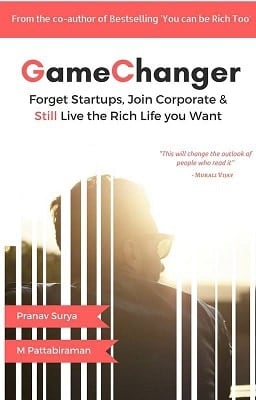Last Updated on December 18, 2021 at 10:44 pm
Thanks mainly to personal finance bloggers, more and more individuals are recognising to the need to treat inflation as the benchmark for long-term goals. With this comes the inevitable realisation that investments that have an insurance component in them – endowment plans, money-back plans, traditional with-profit plans and market-linked ULIPs etc. are unlikely to help them achieve their goals.
This is because the poor return offered by these policies – (5-7% tax-free) for traditional plans – implies for a person to meet long-term goals, the premium will have to much, much higher than what they can afford. This is the only way to beat inflation with such products.
Since most people cannot afford high premiums, the only other option to beat inflation is to invest the amount in assets that can result in a return higher than inflation after taxes. The natural choice is equity.
However, before the person can begin equity investments, the question of what to do with existing ‘junk’ policies must be answered.
Join 32,000+ readers and get free money management solutions delivered to your inbox! Subscribe to get posts via email! (Link takes you to our email sign-up form)
🔥Want to create a complete financial plan? Learn goal-based investing? Exclusive access to our DIY tools? Increase your income with your skills? Enjoy massive discounts on our robo-advisory tool & courses! 🔥
I have taken up this issue from a logical standpoint earlier:
- OMG! Just Realized My Insurance Policies are Worthless! What do I do?
- Insurance Policy Surrender Value & Paid-up Value Calculator
In this post, I would like to offer a simpler thumb-rule approach to this issue while not diluting the associated logic.
Step 1: Do I have enough life insurance? If yes, proceed to step 2. If not, find out how much insurance you need,
- with this tool, if you have dependents other than children: Insurance Calculator for the Young
- and with this tool if you have children, comprehensive child planner
- The above exercise with take no more than 30 mins.
- You can declare your existing policies to the insurer and tell them that you intend to get rid of these once the term plan is issued.
Step 2: Say this to yourself: I decide to stop paying any more premiums for worthless products. I decide invest this sum productively as soon as possible, preferably from the current month.
This is the key step. Once you have decided to accomplish this, it does not matter whether you make the policy paid-up or surrender it. The exit option is irrelevant. The key is to head for the exit.
Making a policy paid-up implies, premiums stops but the relationship with the insurer continues with lesser insurance cover. At the end of the policy duration, the money due to you at the time of making the policy paid-up will be given to you. So the insurer retains the money (investing it to their benefit) and give it to you after (several) years.
Surrendering a policy implies all ties with insurer are immediately severed. The insurer pays a surrender value (much lower tha paid-up value) but pays it immediately.

Step 3:
(a) Some people ask,
“I have paid only one premium and have two more years to exit the policy. What do I do?”
Answer: It is only money. Let it go. Stop paying further premiums.
or
“I have paid two premiums and have one more year to exit the policy. What do I do?”
Answer: You pay one more premium which you will lose anyway when you exit! Makes no sense. It is only money. Let it go. Stop further payment.
(b) If you have less than 5Y left in the policy period, best not to exit. Future premiums when invested elsewhere should be able to get about 7% after taxes. This may not be possible for those in 20% and 10% tax slabs. Why take the chance?
(c) If you have 5Y-10Y left in the policy period, you can exit the policy and invest future premiums in a portfolio with limited equity exposure. Examples are debt oriented balanced funds (MIPs) or even equity-oriented balanced funds if you can understand and stomach the risk (not an easy task for those used to fixed-income products).
In such cases, should one surrender or make the policy pre-paid?
It is not about money. Not about in which option one would lose more or gain more. It is psychology!
Paid-up offers some emotional benefits. The perceived loss is lower. There is some insurer cover and it makes the insurer do some work for the worthless product that you have got from them. The time value of money (paid-up amount sleeps with the insurer from investors point of view) should be taken into account, but we are not applying logic here.
Surrendering offers different emotional benefits. You have cleared the slate: good riddance to bad rubbish*. You can now invest the surrender amount productively along with future premiums.
- rubbish here is not the product or the agent who sold you the product, but your own lazy, uninformed avatar.
The question is not which option is better from a monetary point of view. The question is which option is better from an emotional viewpoint. Which would make you happy? Choose that option. Simple as that.
(d) If you have more than 10Y left in the policy period, exiting via surrender is the obvious choice. This is because both the surrender value and future premiums can be invested in productive assets.
🔥Enjoy massive discounts on our courses, robo-advisory tool and exclusive investor circle! 🔥& join our community of 7000+ users!
Use our Robo-advisory Tool for a start-to-finish financial plan! ⇐ More than 2,500 investors and advisors use this!
Track your mutual funds and stock investments with this Google Sheet!
We also publish monthly equity mutual funds, debt and hybrid mutual funds, index funds and ETF screeners and momentum, low-volatility stock screeners.





- Do you have a comment about the above article? Reach out to us on Twitter: @freefincal or @pattufreefincal
- Have a question? Subscribe to our newsletter using the form below.
- Hit 'reply' to any email from us! We do not offer personalized investment advice. We can write a detailed article without mentioning your name if you have a generic question.
Join 32,000+ readers and get free money management solutions delivered to your inbox! Subscribe to get posts via email! (Link takes you to our email sign-up form)
About The Author
 Dr M. Pattabiraman(PhD) is the founder, managing editor and primary author of freefincal. He is an associate professor at the Indian Institute of Technology, Madras. He has over ten years of experience publishing news analysis, research and financial product development. Connect with him via Twitter(X), Linkedin, or YouTube. Pattabiraman has co-authored three print books: (1) You can be rich too with goal-based investing (CNBC TV18) for DIY investors. (2) Gamechanger for young earners. (3) Chinchu Gets a Superpower! for kids. He has also written seven other free e-books on various money management topics. He is a patron and co-founder of “Fee-only India,” an organisation promoting unbiased, commission-free investment advice.
Dr M. Pattabiraman(PhD) is the founder, managing editor and primary author of freefincal. He is an associate professor at the Indian Institute of Technology, Madras. He has over ten years of experience publishing news analysis, research and financial product development. Connect with him via Twitter(X), Linkedin, or YouTube. Pattabiraman has co-authored three print books: (1) You can be rich too with goal-based investing (CNBC TV18) for DIY investors. (2) Gamechanger for young earners. (3) Chinchu Gets a Superpower! for kids. He has also written seven other free e-books on various money management topics. He is a patron and co-founder of “Fee-only India,” an organisation promoting unbiased, commission-free investment advice.Our flagship course! Learn to manage your portfolio like a pro to achieve your goals regardless of market conditions! ⇐ More than 3,000 investors and advisors are part of our exclusive community! Get clarity on how to plan for your goals and achieve the necessary corpus no matter the market condition is!! Watch the first lecture for free! One-time payment! No recurring fees! Life-long access to videos! Reduce fear, uncertainty and doubt while investing! Learn how to plan for your goals before and after retirement with confidence.
Our new course! Increase your income by getting people to pay for your skills! ⇐ More than 700 salaried employees, entrepreneurs and financial advisors are part of our exclusive community! Learn how to get people to pay for your skills! Whether you are a professional or small business owner who wants more clients via online visibility or a salaried person wanting a side income or passive income, we will show you how to achieve this by showcasing your skills and building a community that trusts and pays you! (watch 1st lecture for free). One-time payment! No recurring fees! Life-long access to videos!
Our new book for kids: “Chinchu Gets a Superpower!” is now available!


Must-read book even for adults! This is something that every parent should teach their kids right from their young age. The importance of money management and decision making based on their wants and needs. Very nicely written in simple terms. - Arun.Buy the book: Chinchu gets a superpower for your child!
How to profit from content writing: Our new ebook is for those interested in getting side income via content writing. It is available at a 50% discount for Rs. 500 only!
Do you want to check if the market is overvalued or undervalued? Use our market valuation tool (it will work with any index!), or get the Tactical Buy/Sell timing tool!
We publish monthly mutual fund screeners and momentum, low-volatility stock screeners.
About freefincal & its content policy. Freefincal is a News Media Organization dedicated to providing original analysis, reports, reviews and insights on mutual funds, stocks, investing, retirement and personal finance developments. We do so without conflict of interest and bias. Follow us on Google News. Freefincal serves more than three million readers a year (5 million page views) with articles based only on factual information and detailed analysis by its authors. All statements made will be verified with credible and knowledgeable sources before publication. Freefincal does not publish paid articles, promotions, PR, satire or opinions without data. All opinions will be inferences backed by verifiable, reproducible evidence/data. Contact information: To get in touch, use this contact form. (Sponsored posts or paid collaborations will not be entertained.)
Connect with us on social media
- Twitter @freefincal
- Subscribe to our YouTube Videos
- Posts feed via Feedburner.
Our publications
You Can Be Rich Too with Goal-Based Investing
 Published by CNBC TV18, this book is meant to help you ask the right questions and seek the correct answers, and since it comes with nine online calculators, you can also create custom solutions for your lifestyle! Get it now.
Published by CNBC TV18, this book is meant to help you ask the right questions and seek the correct answers, and since it comes with nine online calculators, you can also create custom solutions for your lifestyle! Get it now.Gamechanger: Forget Startups, Join Corporate & Still Live the Rich Life You Want
 This book is meant for young earners to get their basics right from day one! It will also help you travel to exotic places at a low cost! Get it or gift it to a young earner.
This book is meant for young earners to get their basics right from day one! It will also help you travel to exotic places at a low cost! Get it or gift it to a young earner.Your Ultimate Guide to Travel
 This is an in-depth dive into vacation planning, finding cheap flights, budget accommodation, what to do when travelling, and how travelling slowly is better financially and psychologically, with links to the web pages and hand-holding at every step. Get the pdf for Rs 300 (instant download)
This is an in-depth dive into vacation planning, finding cheap flights, budget accommodation, what to do when travelling, and how travelling slowly is better financially and psychologically, with links to the web pages and hand-holding at every step. Get the pdf for Rs 300 (instant download)